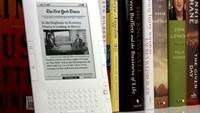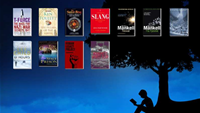Devices that display electronic books were highlights of last month's Consumer Electronics Show in Las Vegas but an Australian developer of such e-readers wasn't there to see it. He was too busy getting ready for his first units to be delivered from the factory in China.
Mike Ottoy has been tooling around with e-readers since the Softbook, the first such device of its kind, which 10 years ago promised a revolution in reading habits that never eventuated. Unlike the Softbook and most of its descendents, Ottoy's Ubiq QuokkaPad uses a liquid crystal display instead of electronic ink, a static display that retains its image when the power is off.
Ottoy, who runs Adelaide document management and service desk reseller eInfo Solutions, says the QuokkaPad evolved from those early trials of the Softbook with Rupert Murdoch's News Ltd, aviation, defence and education customers.
He says whether people felt comfortable with the devices all came down to posture.
"What we discovered in the enterprise and schools and universities was that if a person can sit and read a device in the same manner they would a book then after a short period they started equating the device to a book," Ottoy says.
"The simple answer is your posture - if they can slouch in a chair or hang on a strap in a bus and read they would do it."
Ubiq's device evolved from early proofs of concept with companies such as airline Ansett that, shortly before it failed in 2001, found it could slash its $17 million-a-year flight manual distribution costs using electronic distribution via e-books.
And it was influenced by users' early frustration with single-purpose devices.
"The downside was that, as with the current spate of e-books, those e-books back then were all single-purpose - to read a book - but when someone has a bit of technology like that they get frustrated if they can't do other things such as reading PDF files, sending and receiving emails and web browsing," Ottoy says.
"People in the field usually carry corporate procedural information and if they're engineers they carry technical documents.
"A lot of corporate applications run on the web and may just download documents from the website - it won't all neatly be in e-book form." The bottom line was that it had to be a multi-purpose, standalone device.
QuokkaPad is one of an emerging, low-cost class of mobile device bigger than a smartphone but more agile than a less-functional net book. They are to tablet PCs as netbooks are to notebooks.
The 400MHz MIPS device uses the open source FBReader to read non-protected e-book formats such ePub and Mobipocket and other software to display PDFs and Microsoft Word and it will come with a free subscription to online libraries. And it has a web browser to enable mobile workers to access corporate policies and intranets while on the road, he says.
The device, which has a 21-centimetre colour display, arrived in the country soon after Amazon's new Kindle DX worldwide edition, available in Australia directly from the online bookseller from last month. At the time of writing, Apple was rumoured to be about to launch a similar device, the "iSlate", based on its own operating system.
And even Microsoft looks set to have another crack at the tablet PC that it pioneered nearly a decade ago with a revamped "slate" developed by HP and unveiled by the software maker's chief executive Steve Ballmer last month at the Consumer Electronics Show in Las Vegas (see timeline below).
E-readers book better sales
Alexander Turcic's passion is e-readers and their e-book content. As founder and wrangler for the e-reader community, mobileread.com, he is tapped into the desires of an emerging class of consumer.
He says Amazon's DX was an "important development for the e-book movement outside the US".
"The problem abroad has been that many publishers felt reassured in defending their paper territory, making e-books as unpleasant an experience as possible," Turcic says.
"Whether riddled by complicated DRM [digital rights management], anti-copying procedures or restricted by a very limited choice of book titles. It needs someone like Amazon to achieve what Apple did in the music industry - put enough pressure on the [publishing] industry to force them to embrace the new technology rather than oppose it."
He says the growing popularity of the segment that analyst Forrester recently revised up to 10 million units in readers' hands by the end of the year - more if Apple's iSlate catches on - will accelerate as models come to market.
"When I visited the Frankfurt Book Fair two years ago, almost nobody seemed interested in e-books and only two known players were on the market: Sony and iRex," he says. "The iRex rep told me that his company wasn't afraid of Amazon because with [more] companies and devices production costs would go down."
And the spread of the ePub format adopted by the likes of Sony as the de facto standard will make buyers less nervous of being locked into an e-reader maker's proprietary format, he says.
"As a Sony customer, I was able to re-download all of my e-books in ePub format, which I could then read on other devices as well," he says. "One of the reasons why ePub has become successful in recent months is Amazon's dominance.
"Smaller players realised that the best chance to compete is to embrace ePub."
Mind the fine print
Education and corporate policies are two areas often cited by proponents as areas where the technology shines. But e-book watcher Charlie Perry, who blogs at bookbookblog.com.au, cautions that electronic ink has its limitations.
"E-ink is slow," Perry says. "It's too slow for anything which requires lots of clicking and scrolling. It's fine for reading books and long documents but for something like accounting standards and training documents I would say it's just too slow."
And e-ink is "not a patch" on LCD, he adds.
"As soon as the LCD manufacturers sort out the battery life and backlighting issue I think e-ink will be dead in the water," says Perry.
Timeline
- 1971 Michael Hart launched Gutenberg Project
- 1985-92 Robert Stein started Voyager Company, books on CD-ROM
- 1993 Zahur Zapata developed software to read digital books. Digital Book Inc offered first digital books on floppy in Digital Book Format
- 1995 Amazon sold physical books on the Internet
- 1996 Gutenberg had 1000 titles. SoftBook founded
- 1998 First e-book readers: Rocket e-book and SoftBook
- 1998-99 eReader.com and eReads.com websites sell e-books
- 1999 MIT spin-off E Ink releases first electronic ink product, Immedia big-area displays that drew 0.1 watts of power (a 100w light bulb could power 1000 such signs).
- 2000 Gemstar-TV Guide bought Softbook and Rocket e-book makers. Stephen King sold his book Riding the Bullet as a download
- 2005 Amazon buys Mobi-pocket. Philips spin-off iRex released iLiad e-reader for $US699
- 2006 Sony sold Sony Reader with e-ink
- 2007 Amazon launched Kindle
- 2008 Amazon launched Kindle 2
- 2009 Amazon released the Kindle DX. Barnes and Noble bought e-book seller Fictionwise for $US15.7 million
- 2010 Amazon released the Kindle DX International Edition in Australia. Microsoft showed HP device at CES
Source: Wikipedia, Gizmodo










_(11).jpg&h=142&w=230&c=1&s=1)

.jpg&w=100&c=1&s=0)
_(8).jpg&w=100&c=1&s=0)







.jpg&q=95&h=298&w=480&c=1&s=1)


.jpg&q=95&h=298&w=480&c=1&s=1)


